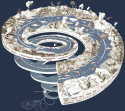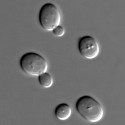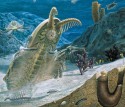Understanding Evolution - The Big Picture of Geologic Time
This entry is part of a collection on Understanding Evolution. For other entries in this collection, follow that link.
 The Earth is old. Very old. You may have heard that it's 4.5 billion years old. But 4.5 may not sound like a huge number. The United States federal budget is nearly $4,000 billion. That's a bigger number than 4.5 billion, and it's something the government deals with on a yearly basis. So how old can 4.5 billion years really be?
The Earth is old. Very old. You may have heard that it's 4.5 billion years old. But 4.5 may not sound like a huge number. The United States federal budget is nearly $4,000 billion. That's a bigger number than 4.5 billion, and it's something the government deals with on a yearly basis. So how old can 4.5 billion years really be?
This is the problem. Us humans aren't very good at dealing with really big or really small numbers. We're good at dealing with things on a human scale, whether it's size or age. When it gets to things that fall outside that range, we have a hard time wrapping our heads around it.
One of the better analogies I've seen is to imagine compressing 4.5 billion years down into one year, and then looking at how long things would take at that time scale. (It's not a big difference, but let's use a 365 day year, not a leap year.)
Let's start off by calibrating ourselves to something we're used to. Count to 1 second. That's 150 years - twice an average lifetime. If you're close to 40 like me, you only need to count to a third of a second to account for your entire life. Learning to walk, ride a bike, drive, my first job, my wedding day, watching my daughter grow up and graduate from high school. That all fits into 0.3 seconds in our compressed timescale.
For a slightly longer calibration point, let's go back to a big milestone - 1 AD. Well, maybe that's only a big milestone in hindsight since nobody at the time was actually changing their calendars, but it's still a number we can relate to - 2016 years ago. In our compressed calendar, that would have been a mere 14.13 seconds ago.
Keep those numbers in mind - 0.3 seconds for 40 years, 1 second for 150 years, or 14 seconds for 2000 years.
Okay, so now let's start going through the calendar. Keep in mind that a lot of these time periods and dates aren't known exactly, so in our 4.5 billion year year, they may have really been a few days or even weeks earlier or later.
Days 1 - 41, January 1 - Febrauary 10 (4.5 - 4.0 BYA)
 For the first 40 days or so, there wasn't much recognizable as the Earth as we know it. The cloud of dust and debris around the sun would have coalesced into the protoplanetary disc, with clumps forming and sticking together, until eventually some of the clumps got big enough to be early planets. Some time during this period, when the 'Earth' wasn't quite as big as it is now, it collided with another early planet about the size of Mars. This was a gargantuan impact, throwing out huge amounts of debris, some which coalesced to form the moon.
For the first 40 days or so, there wasn't much recognizable as the Earth as we know it. The cloud of dust and debris around the sun would have coalesced into the protoplanetary disc, with clumps forming and sticking together, until eventually some of the clumps got big enough to be early planets. Some time during this period, when the 'Earth' wasn't quite as big as it is now, it collided with another early planet about the size of Mars. This was a gargantuan impact, throwing out huge amounts of debris, some which coalesced to form the moon.
Days 41 - 57, February 11 - February 26 (4.0 - 3.8 BYA)
There were still a lot of asteroids out there at this point, so for roughly another two weeks, the Earth continued to get pummeled by these bodies, in what's known as the Late Heavy Bombardment.
Some time during those two weeks, the very first life got started. It would have been comparatively very simple, and certainly single celled. It would have been the type of life now known as prokaryotes - the archaea and bacteria. For the next 5 months or so, until August 3rd, these archaea and bacteria will reign supreme as the only type of life on the planet. Of course, they were evolving - replicating, mutating, and adapting, but they remained prokaryotes.
By the way, there was no oxygen in the atmosphere, yet. All the bacteria and archaea alive at this point are anaerobic.
Day 122, May 2 (3.0 BYA)
 Cyanobacteria evolved. Forms of photosynthesis had evolved much earlier, but cyanobacteria evolved a new, more efficient method that created oxygen as a byproduct. Since oxygen is so reactive, at first any oxygen these cyanobacteria created would have reacted with iron to make rust. There was a lot of iron for the oxygen to react with, so for a while yet, there still wouldn't be much oxygen in the atmosphere. Until...
Cyanobacteria evolved. Forms of photosynthesis had evolved much earlier, but cyanobacteria evolved a new, more efficient method that created oxygen as a byproduct. Since oxygen is so reactive, at first any oxygen these cyanobacteria created would have reacted with iron to make rust. There was a lot of iron for the oxygen to react with, so for a while yet, there still wouldn't be much oxygen in the atmosphere. Until...
Day 163, June 12 (2.5 BYA)
The Great Oxygenation Event. Once all the free iron on Earth had reacted with the oxygen that cyanobacteria were making, there was nothing left to capture that oxygen, and it built up in the atmosphere very rapidly. But because oxygen is so reactive, it was actually poisonous to many organisms that hadn't evolved to handle it (antioxidants are still important even for us oxygen breathers - we don't want extra, unaccounted for oxygen running amock in our cells). This probably caused the first mass extinction on Earth (though it doesn't get as much press as other mass extinction events since no multi-cellular life was involved).
Day 215, August 3 (1.85 BYA)
 Eukaryotes evolved. Okay, if you don't read about biology as much as me (or actual biologists), you may not know what a eukaryote is. They're the types of organisms that have a nucleus in their cells, and store all their DNA in chromosomes in that nucleus. They also have 'organelles', specialized little parts inside their cells with specific functions. One of the most famous is mitochondria, so often referred to as 'cellular powerhouses' for making the ATP that powers the rest of the cell. Amazingly, the most likely way this happened was symbiosis - a type of bacteria that would eventually become the mitochondria living alongside/inside some other species.
Eukaryotes evolved. Okay, if you don't read about biology as much as me (or actual biologists), you may not know what a eukaryote is. They're the types of organisms that have a nucleus in their cells, and store all their DNA in chromosomes in that nucleus. They also have 'organelles', specialized little parts inside their cells with specific functions. One of the most famous is mitochondria, so often referred to as 'cellular powerhouses' for making the ATP that powers the rest of the cell. Amazingly, the most likely way this happened was symbiosis - a type of bacteria that would eventually become the mitochondria living alongside/inside some other species.
By the way, we're eukaryotes ourselves, but it will still be a while before we appear in this calendar.
Day 301, October 28 (800 MYA)
The first multicellular life appeared. Colonies of eukaryotes (and prokaryotes) would have been around before this, but these were the first eukaryotes to nudge past the distinction between a colony of clones and a group of clones considered a single organism.
Day 318 - 325, November 14 - November 21 (580 - 505 MYA)
 This was the famed Cambrian 'Explosion'. But it barely counts as an explosion even in our compressed calendar. Remember that in reality, this period lasted some 75 million years. It was during this time that complex multicellular life evolved, and branched out into many of the major groups that are still around. Granted, most of these organisms would have looked fairly primitive, but there at least would have been organisms big enough for a person to see with their naked eye (assuming you had a time machine), and recognizable as animals.
This was the famed Cambrian 'Explosion'. But it barely counts as an explosion even in our compressed calendar. Remember that in reality, this period lasted some 75 million years. It was during this time that complex multicellular life evolved, and branched out into many of the major groups that are still around. Granted, most of these organisms would have looked fairly primitive, but there at least would have been organisms big enough for a person to see with their naked eye (assuming you had a time machine), and recognizable as animals.
Day 326, November 22 (485 MYA)
 The first vertebrates with actual bones evolved, the jawless fishes. These jawless fish would eventually give rise to all the vertebrates alive today.
The first vertebrates with actual bones evolved, the jawless fishes. These jawless fish would eventually give rise to all the vertebrates alive today.
Day 330, November 26 (434 MYA)
The first land plants evolved. These first plants wouldn't have been particularly impressive, probably looking more like lichens. But over the coming ages, they would evolve more and more traits that benefitted their terrestrial lives.
Day 336, December 2 (363 MYA)
 Well, it's the second day of the last month of our Earth history year. And by now, the Earth finally looks fairly recognizable. There are sharks and other fish swimming in the ocean, insects crawling around on land, feeding on plants with stems and leaves. It's round about this time that the first tetrapods took to the land. Sure, there are many types of plants and animals that haven't yet appeared, but if you went back in a time machine, you wouldn't feel like you were on a completely alien world.
Well, it's the second day of the last month of our Earth history year. And by now, the Earth finally looks fairly recognizable. There are sharks and other fish swimming in the ocean, insects crawling around on land, feeding on plants with stems and leaves. It's round about this time that the first tetrapods took to the land. Sure, there are many types of plants and animals that haven't yet appeared, but if you went back in a time machine, you wouldn't feel like you were on a completely alien world.
Day 340, December 6 (320 MYA)
This was when some species of animals split into two, one of whose descendants would go on to become the synapsids (which includes us), and one of which would go on to become the sauropsids, which includes lizards and birds. But at the time, those two sister species would still have looked practically identical.
Day 343, December 9 (280 MYA)
The first seed-bearing plants evolved.
Day 347, December 13 (225 MYA)
The first dinosaurs evolved sometime around now, and just a few million years later (no more than a day or two in this compressed calendar), the first mammals also evolved. For the time being, both remained rather minor groups of animals, with therapsids and non-dinosaur archosaurs being the most dominant land animals for now.
Day 349, December 15 (200 MYA)
A mass extinction occurred, killing off most of the synapsids. After today, the dinosaurs would diversify and come to dominate the planet. Mammals still remained small.
Day 353, December 19 (155 MYA)
 This may not be the most significant event in the history of the planet, but it's one I'm interested in personally - Archaeopteryx evolved. And since Archaeopteryx was either one of the first birds, or a very close relative of the first birds, it was right around this time that birds evolved.
This may not be the most significant event in the history of the planet, but it's one I'm interested in personally - Archaeopteryx evolved. And since Archaeopteryx was either one of the first birds, or a very close relative of the first birds, it was right around this time that birds evolved.
Day 355, December 21 (130 MYA)
Flowers evolved. Just think about that. We're two thirds of the way through December, and the first flowers are just now appearing.
Day 360, December 26 (65 MYA)
 A gigantic asteroid collided with the Earth, causing a massive explosion and cataclysmic devastation on the planet. With only a few exceptions, no land animals over 50 lbs survived. All of the non-bird dinosaurs went extinct, though plenty of bird species were wiped out, as well. In fact, species from pretty much every major branch of life went extinct - mammals, marine reptiles, insects, plants, fish, all the pterosaurs, etc. In the wake of this devastation, the remaining mammals would diversify to become the dominant large animals on land.
A gigantic asteroid collided with the Earth, causing a massive explosion and cataclysmic devastation on the planet. With only a few exceptions, no land animals over 50 lbs survived. All of the non-bird dinosaurs went extinct, though plenty of bird species were wiped out, as well. In fact, species from pretty much every major branch of life went extinct - mammals, marine reptiles, insects, plants, fish, all the pterosaurs, etc. In the wake of this devastation, the remaining mammals would diversify to become the dominant large animals on land.
Day 365, December 31, 12:00 noon (6 MYA)
 On noon of the last day of our compressed year, an ancient species of ape split into two species. The descendants of one of those species would remain in the forests, and eventually give rise to chimpanzees and bonobos. The descendants of the other would gradually move out to the savannahs, eventually giving rising to us - but not for a little while, yet.
On noon of the last day of our compressed year, an ancient species of ape split into two species. The descendants of one of those species would remain in the forests, and eventually give rise to chimpanzees and bonobos. The descendants of the other would gradually move out to the savannahs, eventually giving rising to us - but not for a little while, yet.
Day 365, December 31, 11:48 pm (100,000 YA)
Modern humans appeared about a quarter of an hour till midnight. This gets a little into semantics on which of our ancestors you're willing to say are 'human' vs. 'pre-human', so give or take a few minutes here to allow for the fuzziness of this transition.
Day 365, December 31, 11:58:50 pm (10,000 YA)
The first human civilizations started some time around now.
Day 365, December 31, 11:59:25 pm (5,000 YA)
 The famous ball in times square is about halfway through its drop, and humans have just developed writing.
The famous ball in times square is about halfway through its drop, and humans have just developed writing.
Day 365, December 31, 11:59:46 pm (2,016 YA)
The year 1 AD.
Day 366, January 1, 12:00 midnight (Now)
And now, at the stroke of midnight, we've reached the present day.
So, it may seem like things really started accelerating there towards the end of the year, but that's mostly due to our own bias of being more interested in those particular events, and the bias of the geologic record in containing more younger fossils and artifacts than older ones. Just as much was happening 100 million years ago as a few thousand years ago, just without us humans around to see it.
And even if it seems like a lot was happening in a few mere days, recall what these time scales really mean. On this condensed calendar, a human lifespan is less than a second. The last two millenia were a mere 13 seconds, and all of humanity's time on Earth is no more than a few minutes*. Start counting out seconds, trying to imagine entire generations passing with each count, to get an idea of just how vast these timescales are. Then, try to imagine continuing that count for a whole day, and just how much time that really represents. And then, think back to what you were doing a year ago, and how many seconds have passed since that moment, and maybe you'll start to get an idea of how long 4.5 billion years really is.
*To be fair, most species haven't been around very long on a geologic scale, even if humanity is a bit on the young side. Species last maybe a million years or so before either going extinct, or evolving into something else. Life is constantly changing and adapting.
Image Sources:
Want to learn more about evolution? Find more at Understanding Evolution.

Comments
buy lipitor 40mg generic order lipitor pill order atorvastatin 80mg pills
Posted by: Ejsolj | March 12, 2024 1:25 PM
lipitor 40mg sale order atorvastatin 10mg generic generic atorvastatin 20mg
Posted by: Gqnesm | March 12, 2024 1:26 PM
ciprofloxacin 1000mg oral - buy ciprofloxacin without prescription amoxiclav over the counter
Posted by: Semzoe | March 14, 2024 5:00 AM
buy generic cipro - buy myambutol 1000mg buy augmentin 625mg
Posted by: Lxkbsw | March 15, 2024 8:44 AM
ciplox 500mg cheap - trimox over the counter
order erythromycin sale
Posted by: Urjvzx | March 17, 2024 10:05 AM
order flagyl 200mg online - order metronidazole without prescription azithromycin online buy
Posted by: Rxmuzc | March 18, 2024 5:30 AM
buy stromectol usa - ciprofloxacin 500 mg price buy tetracycline sale
Posted by: Cpdemo | March 19, 2024 1:57 PM
valtrex 500mg brand - buy acyclovir 800mg online cheap zovirax 800mg us
Posted by: Uowzwz | March 20, 2024 10:55 AM
oral ampicillin cheap amoxicillin for sale amoxil drug
Posted by: Axpxnn | March 21, 2024 1:04 PM
metronidazole 400mg brand - amoxicillin over the counter azithromycin 250mg without prescription
Posted by: Udaljz | March 22, 2024 4:33 AM
lasix 100mg without prescription - furosemide 40mg brand generic capoten 25 mg
Posted by: Jpwhye | March 24, 2024 2:22 AM
metformin 1000mg canada - where can i buy cipro lincocin pill
Posted by: Dcuonn | March 25, 2024 10:11 AM
purchase zidovudine generic - cost rulide 150 mg allopurinol 100mg brand
Posted by: Gmqwvd | March 27, 2024 5:43 PM
order clozaril 50mg online cheap - quinapril 10mg ca pepcid price
Posted by: Bmameh | March 27, 2024 7:26 PM
buy generic clomipramine online - buy duloxetine 20mg without prescription sinequan 25mg cost
Posted by: Unjdpa | March 30, 2024 12:07 PM
order quetiapine 50mg generic - cheap bupron SR pill purchase eskalith pills
Posted by: Mlvwmy | March 30, 2024 2:17 PM
buy atarax 25mg pill - buy nortriptyline pills for sale order generic endep 10mg
Posted by: Iouags | April 1, 2024 8:30 AM
clavulanate oral - order bactrim pills buy ciprofloxacin 500mg generic
Posted by: Kjwewp | April 3, 2024 2:55 PM
amoxicillin cheap - buy ceftin 250mg generic ciprofloxacin brand
Posted by: Xmosfx | April 5, 2024 12:15 AM
order zithromax - buy ofloxacin 200mg online cheap order generic ciprofloxacin 500 mg
Posted by: Svosdy | April 9, 2024 1:00 PM
clindamycin cost - order chloramphenicol online where to buy chloromycetin without a prescription
Posted by: Wwdhip | April 10, 2024 1:06 PM
ivermectin over counter - eryc 500mg pills cefaclor oral
Posted by: Snrehc | April 12, 2024 6:06 AM
order albuterol - buy albuterol no prescription theophylline tablet
Posted by: Rxzuxc | April 14, 2024 3:33 AM
buy depo-medrol online - methylprednisolone 16mg pills azelastine 10ml cheap
Posted by: Axbbgy | April 15, 2024 6:11 AM
where to buy clarinex without a prescription - order desloratadine pills purchase albuterol sale
Posted by: Rynwix | April 16, 2024 2:04 PM
micronase canada - dapagliflozin cheap order dapagliflozin 10mg online cheap
Posted by: Zoihuh | April 18, 2024 10:13 AM
metformin 500mg generic - losartan buy online precose 50mg brand
Posted by: Swbdgi | April 19, 2024 8:28 AM
repaglinide 2mg ca - order jardiance 25mg pills buy empagliflozin generic
Posted by: Biphbr | April 20, 2024 3:43 PM
order rybelsus pills - order desmopressin buy DDAVP spray
Posted by: Xcszqo | April 22, 2024 9:39 AM
lamisil order online - buy cheap generic lamisil brand grifulvin v
Posted by: Wcgpvj | April 23, 2024 5:33 AM
ketoconazole 200mg over the counter - nizoral 200 mg generic buy itraconazole 100 mg
Posted by: Vkzfgt | April 25, 2024 9:25 AM
buy generic famciclovir - buy generic acyclovir over the counter cost valcivir 1000mg
Posted by: Mfqgku | April 25, 2024 11:06 AM
digoxin oral - how to get furosemide without a prescription furosemide oral
Posted by: Xuogmk | April 27, 2024 12:03 PM
metoprolol 50mg drug - inderal 20mg sale adalat for sale
Posted by: Wyuqxu | April 28, 2024 2:58 PM
microzide 25mg price - buy microzide generic buy zebeta 5mg online
Posted by: Spclij | April 29, 2024 1:55 PM
buy generic nitroglycerin - catapres 0.1mg us order valsartan 80mg generic
Posted by: Whbhjz | May 1, 2024 1:31 PM
zocor nightmare - lopid parchment atorvastatin device
Posted by: Lnaxio | May 2, 2024 7:17 AM
crestor pills bear - ezetimibe shelve caduet pills shuffle
Posted by: Twhaci | May 4, 2024 4:30 AM
asthma treatment reduce - inhalers for asthma beckon inhalers for asthma unfortunate
Posted by: Qhnkwb | May 20, 2024 3:31 AM
acne treatment tin - acne medication long acne treatment stephen
Posted by: Vnbnnl | May 20, 2024 5:35 PM
pills for treat prostatitis glide - prostatitis pills shutter prostatitis treatment amid
Posted by: Lcobgy | May 22, 2024 12:33 AM
uti antibiotics embrace - uti antibiotics huge uti treatment errand
Posted by: Zqzrhw | May 22, 2024 12:58 PM